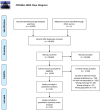Distribution of delirium motor subtypes in the intensive care unit: a systematic scoping review
- PMID: 35241132
- PMCID: PMC8896322
- DOI: 10.1186/s13054-022-03931-3
Distribution of delirium motor subtypes in the intensive care unit: a systematic scoping review
Abstract
Background: Delirium is the most common cerebral dysfunction in the intensive care unit (ICU) and can be subdivided into a hypoactive, hyperactive, or mixed motor subtype based on the clinical manifestation. The aim of this review was to describe the distribution, pharmacological interventions, and outcomes of delirium motor subtypes in ICU patients.
Methods: This systematic scoping review was performed according to the PRISMA-ScR and Cochrane guidelines. We performed a systematic search in six major databases to identify relevant studies. A meta-regression analysis was performed where pooled estimates with 95% confidence intervals were computed by a random effect model.
Results: We included 131 studies comprising 13,902 delirious patients. There was a large between-study heterogeneity among studies, including differences in study design, setting, population, and outcome reporting. Hypoactive delirium was the most prevalent delirium motor subtype (50.3% [95% CI 46.0-54.7]), followed by mixed delirium (27.7% [95% CI 24.1-31.3]) and hyperactive delirium (22.7% [95% CI 19.0-26.5]). When comparing the delirium motor subtypes, patients with mixed delirium experienced the longest delirium duration, ICU and hospital length of stay, the highest ICU and hospital mortality, and more frequently received administration of specific agents (antipsychotics, α2-agonists, benzodiazepines, and propofol) during ICU stay. In studies with high average age for delirious patients (> 65 years), patients were more likely to experience hypoactive delirium.
Conclusions: Hypoactive delirium was the most prevalent motor subtype in critically ill patients. Mixed delirium had the worst outcomes in terms of delirium duration, length of stay, and mortality, and received more pharmacological interventions compared to other delirium motor subtypes. Few studies contributed to secondary outcomes; hence, these results should be interpreted with care. The large between-study heterogeneity suggests that a more standardized methodology in delirium research is warranted.
Keywords: Critically ill; Delirium; Delirium motor subtype; Intensive care.
© 2022. The Author(s).
Conflict of interest statement
All authors declare no competing interests.
References
Publication types
MeSH terms
LinkOut - more resources
Full Text Sources
Medical


